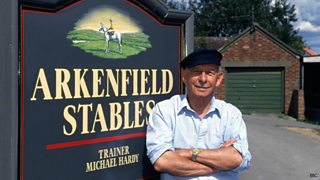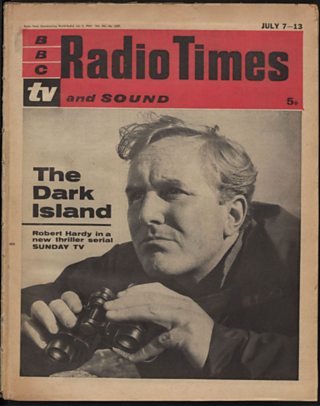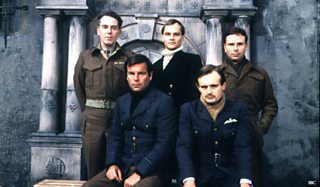
Producer Gerard Glaister on the set of horse-racing drama Trainer
Gerard Glaister appears in many Radio Times credits from the 1950s through to the early 1990s as the producer of a string of well-remembered dramas. His career encompassed British television from the days of live transmission, to all-film, single camera production at the dawn of the modern era.
He identified emerging trends in popular drama, and working with some of the most talented middle-range writers and directors – people who were never in danger of being labelled auteurs but knew how to tell a story – he was able to produce a high standard of material for nearly forty years. Glaister perhaps had auteur inclinations of his own, as many of the series he worked on were devised by himself in collaboration with other writers, even if he rarely wrote the actual scripts.
Born in Hong Kong in December 1915, Glaister came from a medical family, with his uncle and grandfather both eminent forensic scientists. Against the family tradition, Glaister was drawn to acting, and studied at RADA in the 1930s. He joined the RAF before the outbreak of the Second World War, and flew light bombers before serving in photo reconnaissance, ending up in a succession of important jobs in intelligence.
After the war he returned to the theatre, and ran companies at Luton and Aylesbury before he was invited to take charge of the Chesterfield Repertory Company in 1954. His first contact with television was as a writer, when his play , written with Gavin Holt, was adapted. �������� Television expanded in the mid-1950s, and there was also demand for extra staff to replace those tempted over to the newly-opened ITV. Glaister won a place on the �������� directors’ course, and spent six months studying the art of television, part of it under the aegis of legendary producer .
Glaister was then offered a contract as a producer/director, as producers were at the time expected to be able to take charge of a studio as well as supervise. Until the very end of his career he chose never to be a full-time �������� staff member, but nevertheless worked almost exclusively for the Corporation for the whole of his TV career. This status however allowed him to take due credit when he co-devised a series – as a �������� staff member any such contribution would have been anonymous.
In the mid-50s much of �������� drama output was single plays, often taken from the theatre, but drama serials were increasing in number, and many (other than classic novel adaptations) were specially written. Another growing area was drama documentary – the technical difficulty of filming real life situations meant that it was easier to recreate then in the studio. Glaister would contribute to all these areas as he learnt his craft.
His first productions and were solely as a director, with a separate producer overseeing his work. For his next job, J.B. Priestley’s , he handled production as well as directing in the studio. 1957 was his first year working for �������� TV, and he was busy with a total of five single plays, plus his first serial – , by crime novelist Michael Gilbert.
1958 would see Glaister handle only one play, as apart from a six-part serial by Berkely Mather called , he was busy producing – the first �������� soap opera transmitted twice a week. Glaister lasted for nearly nine months before handing over to a colleague for the remainder of this short-lived series.

Radio Times promotes the new thriller serial The Dark Island in summer 1962
The next two years saw Glaister return to the familiar pattern of plays and serials, the latter including , a series of two-part crime stories, half of which he also directed. One of the plays he handled in 1960 was a drama documentary, , which as the title suggests was about the drugs trade, set in Glaister’s birthplace, Hong Kong.
In December 1960 Glaister directed the first of eight episodes of the new crime series Maigret that he would handle in its first three years. This was a very successful series, based on the novels by Georges Simenon. Programmes such as this, where regular characters featured in a different story each week, had developed since the mid-50s, as an alternative to single-shot plays or episodic serials.
As producer/director, Glaister was also in charge of another popular six-part thriller, , written by Robert Barr and starring Robert Hardy, which was set on the Hebridean island of Benbecula, and featured memorable a theme tune - an important element in the appeal of any series. It would not be the last time Glaister featured a Scottish location in one of his productions.
During this time Glaister also made a rare foray outside the ��������, as he directed several episodes of the Edgar Wallace Mysteries. These were short second-feature cinema films, which were later also shown on television.
By 1963 he was ready to tackle another long �������� series as producer, and for the first time this was something that harked back to his wartime service: the drama , which was about special agents of the SOE being flown into occupied France. This was still produced live with little filming allowance, which constrained the realism of the show; sequences of Lysander aircraft bringing agents in had to be achieved with model shots – with less than convincing results.
Glaister bowed out of this series again before it finished, and spent the rest of the year directing an adaptation of Robert Louis Stevenson’s novels and its sequel Catriona. His work continued to have a Scottish flavour, as he directed half a dozen episodes of the popular period medical drama , which led to him being offered the producer’s job from ; he stayed for over a year.
He next took over production of another series, , about an idealistic secondary school teacher, which was Glaister’s first series to be shown on ��������2. Its earliest episodes were also shown by �������� Scotland (the equivalent of ��������1), as ��������2 was not yet available there – though the series was both set and made in that country. So too was his next project (1966-68), about the elite Investigation Branch of Customs and Excise.
Later in 1968 Glaister drew on another aspect of his background, and made use of his uncle John Glaister as consultant, for , starring Marius Goring as pathologist Dr John Hardy. This was the first continuing drama made in colour by the ��������, and so it had to be on ��������2 again, as the only channel broadcasting in colour at the time. An intelligent and gripping series, though it got comparatively small audiences, it also saw Glaister credited as co-deviser for the first time, with writer N.J. Crisp. There were four series of The Expert, Glaister producing the first three.

The stars of Glaister's brilliant prisoner-of-war series Colditz - Jack Hedley, Christopher Neame, Edward Hardwicke, Robert Wagner and David McCallum
1971 saw Glaister begin a new business/family saga, , which would in fact sit on the shelf until 1972. Again devised with N.J. Crisp, this became one of the big hits of the early- to mid-70s, straying into soap opera territory, with a boo-able villain with the advent of the unscrupulous Paul Merroney (Colin Baker). Glaister would only remain producer until the end of the second series, which had seen one of the main actors replaced as he was no longer available after the delay in showing series 1.
1972 also saw Glaister return to World War Two for one of his greatest and best-remembered series – , devised with Brian Degas. Based on the memoirs of Pat Reid, who got out of the ‘escape-proof’ fortress in 1942, there had been a film version in the 50s, and the �������� acknowledged its debt to that. Co-producing the series with Universal Television meant casting could be more ambitious, with Robert Wagner and David McCallum among the leads – the former’s presence, before the entry of the US into the war, explained as his being an American pilot who volunteered for service with the RAF.
Colditz boasted high-quality scripts and some excellent performances, with Jack Hedley and Edward Hardwicke amongst the British prisoner contingent, and a superb Bernard Hepton as the German Kommandant. The in 1974 saw Anthony Valentine join as a Luftwaffe officer as second-in-command of the prison – another popular ‘baddie’.
Glaister found it hard at first to follow this success, as another idea with N.J. Crisp, , only ran for six episodes, and was the only time Glaister did not produce one of his own ideas. His topical drama was never as successful as the 1960s oil industry series The Troubleshooters.
1976 saw no new series produced by Glaister, though he directed the first episode of the revived series of . He returned to production in 1977 with rural Scottish vet drama , starring Dr Finlay’s Bill Simpson, but he would only produce four of the thirteen episodes, and the series was not a hit.
However, success was just around the corner, as late 1977 saw the start of . A kind of thematic spin-off from Colditz (this time co-devised with Wilfred Greatorex), this concerned an organisation dedicated to helping shot-down Allied aircrews escape from occupied Europe. Set in Brussels, it benefitted from co-production with Belgian television, with some effective authentic location shooting.
Unlike earlier war stories, Secret Army featured strong female characters, but like Colditz showed both heroes and villains as multi-dimensional characters. The concept lent itself to a surprising range of stories, and gently educated viewers about everything from the stresses of life under Nazi occupation to bubonic plague, war-time German television experiments and the conflict between Communist and non-Communist sides of the resistance movement.

The cast - and, in the nautical sense, the crew - of Howard's Way, the long running saga of boating folk and horrible 80s fashion - Gerald Glaister's last big hit series
Glaister next produced airline drama , which again was not a huge hit, and only lasted one year – it is chiefly memorable for the lead character being called Tony Blair, though being made in 1980 the name had no other significance then. This was followed by another six-part thriller, , an exciting though slightly old-fashioned tale, despite featuring modern tropes like international terrorists. It had originally been titled Blood Royal, and concerned the kidnap of a child in line to the throne – this was changed at the request of Buckingham Palace, to the son of a UN official, memories of the kidnap attempt on Princess Anne in the early 70s still being fresh in the mind.
The stand-out character in the series was Captain Percival, a suave ‘spook’ played by Michael Denison, who would go on to appear in two future Glaister-produced series, in 1983, and in 1984.
The shadow of Secret Army would not go away however. The final series had been slightly troublesome – while what appeared on screen was a satisfying conclusion, with the bizarre but historically correct execution of one of the German characters by his own side in a prisoner-of-war camp, there had been another episode made which was never screened.
Called What Did You Do In the War, Daddy?, the episode was set in 1969, but didn’t really fit with the series. Glaister and his script editor John Brason then devised a six-episode sequel called , which showed how Nazi-hunters went after Secret Army's eponymous head of the Gestapo in Brussels, who had re-invented himself as a businessman called Manfred Dorf.
Another series inspired by Secret Army was the disappointing , which expanded an idea from the former series to show how special agents infiltrated occupied Europe in World War Two to try to destroy the Nazi V-weapons. Perhaps a spin-off too many, but this was a recurring theme in Glaister’s work.
Glaister was however working on another series, co-devising this time with Allan Prior, which would prove to be his last big hit – . The story of a redundant aircraft designer who tries his hand at boat-building, this started as a family drama as the title character, Tom Howard’s marriage fell apart.
The series involved a number of themes from the mundane conflict between traditional and modern styles of boat-building, to a lot of high-octane boardroom and bedroom action, which strayed much more into a kind of Dallas/Dynasty soap opera territory. Though highly popular it was slammed by critics, and got gradually more arch and camp as it went on. When star Maurice Colbourne died unexpectedly just before the final series, it was decided not to continue.
Gerard Glaister’s last series as co-creator (with Tony Lakin) and producer was . As with other series this arose from an idea touched on in a predecessor, in this case a horse-racing plotline in Howard’s Way. Though it ran for two seasons, Trainer was not well-received critically – like Howard’s Way it presented a glamorised version of the world it portrayed, in this case thoroughbred horse-training.
By the time Trainer ended in 1992, Glaister was in his mid-70s and decided to retire from the business, enjoying time with his family and hobbies until his death in 2005 at the age of 89. While not every series he was involved in was a success, his strike-rate was impressive, and among the series he supervised are some of the most impressive television dramas of the so-called ‘golden age of television’.
Do you have fond memories of Gerard Glaister’s television productions? What other classic dramas were unmissable appointments-to-view for you? Let us know what you think…
